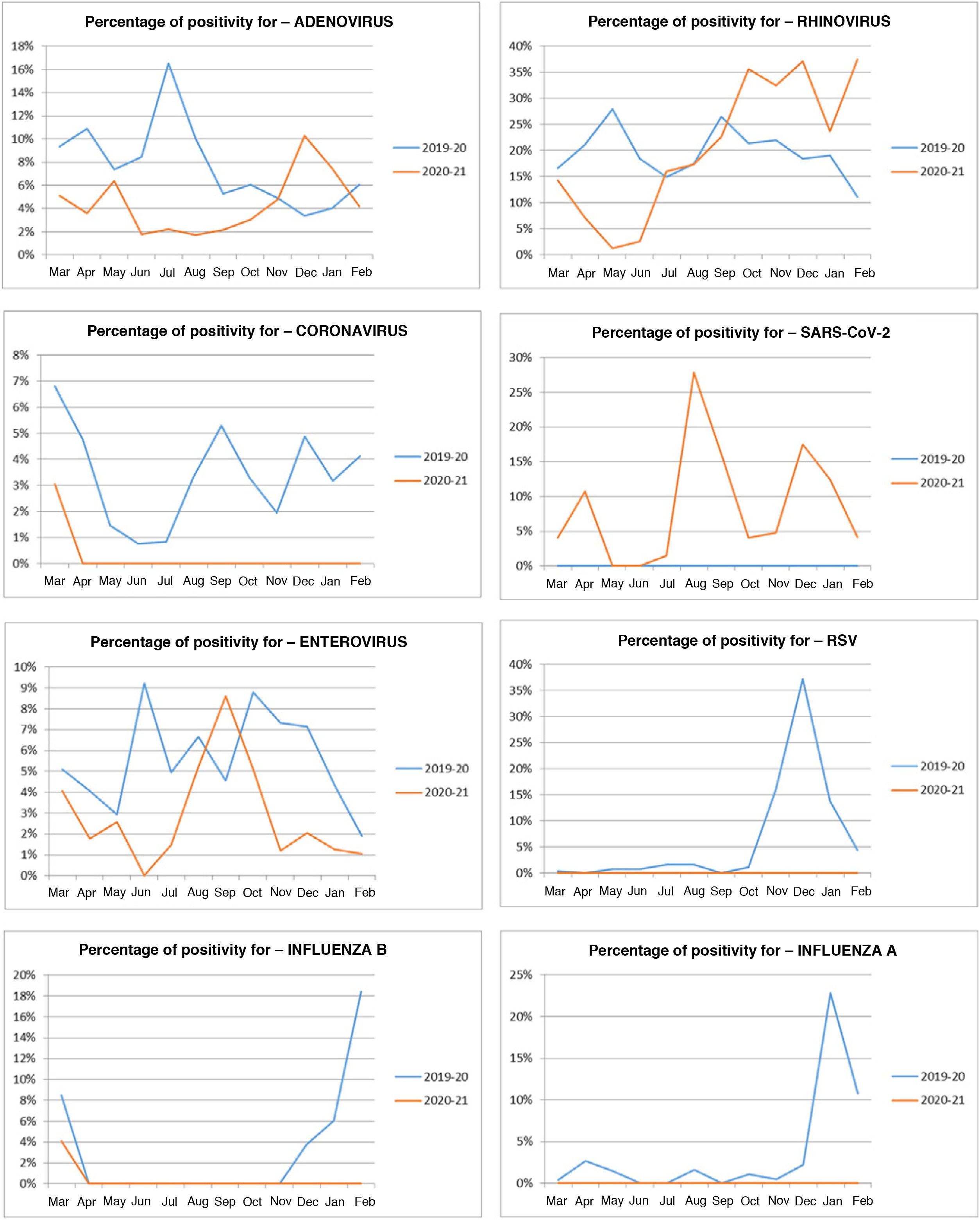Following the declaration of the state of alarm due to the SARS-CoV-2 pandemic on 14 March 2020 in Spain, the number of respiratory infections in paediatrics fell considerably. The transmission of viral infections occurs mostly through respiratory droplets, aerosols or fomites. Home confinement, the closure of schools and the mandatory wearing of face-covering have led to a change in the epidemiology of common viral infections, with a significant decrease in viral epidemics such as influenza or acute bronchiolitis.1,2
The objective of this study was to analyse the incidence and changes in the aetiology of infections caused by respiratory viruses in paediatrics during the SARS-CoV-2 pandemic. We carried out a single-centre retrospective observational study in the Paediatric Department of a tertiary hospital. We compared respiratory viral infections from two year-long periods: 14 March 2020 to 14 March 2021 (CoV-period) versus the same time interval for the previous year, 2019-2020 (pre-CoV period). Our centre uses a commercial real-time technique that simultaneously and differentially detects 21 respiratory viruses (Allplex Respiratory Assay-Seegene, South Korea). The PCR test for SARS-CoV-2 is performed using a commercial real-time RT-PCR technique (Allplex 2019-nCov Assay-Seegene and the TaqPathTM COVID-19 CE-IVD RT-PCR-Kit). The data were obtained from the electronic registry of the hospital's medical records.
During the year of the pandemic (CoV-period), there was a 68% reduction in visits to the Accident and Emergency for respiratory disease (CoV-period 2,455, pre-CoV 7,697) and a 63% reduction in respiratory admissions (CoV-period 263, pre-CoV 713). During the pandemic, a total of 1,144 PCR were analysed, representing a decrease of 51% compared to the pre-CoV period, with an overall positivity percentage of 6% vs 10% pre-Cov period (CoV-period 416, pre-CoV 1,365; p<0.01).
The median age of patients with viral respiratory infection was 26 months; interquartile range (IQR) 64-147 (pre-CoV 25 months, IQR 55-136, p=0.04). There was an increase in patients seen in the 6-9 year-old age group, representing 12.3% (pre-CoV 10.8%; p<0.01), and in over-10 year-olds, which was 9.5% (pre-CoV 7.4%, p<0.01).
Fig. 1 shows the incidence of the main respiratory viruses and changes over the study period. All the viruses showed a decrease in the positivity rate of the samples analysed. The viruses which decreased the least during the pandemic were: rhinovirus, with 238 cases during the COV-period (pre-CoV 440; p<0.01); adenovirus, with 48 cases during the CoV-period (pre-CoV 161; p<0.01); and enteroviruses, with 33 cases in the CoV-period (pre-CoV 125; p<0.01). A total of 98 SARS-CoV-2 infections were detected in our hospital.
Regarding the respiratory infectious aetiology, the most significant decrease was found in acute bronchiolitis, being 91.4% (CoV-period 33, pre-CoV 385; p<0.01), followed by pneumonia, with a decrease of 87.8% (CoV-period 50, pre-CoV 409; p<0.01) and acute laryngitis, which fell by 79% (CoV-period 100, pre-CoV 477, p<0.01).
Numerous studies have shown how social distancing measures and the closure of educational centres led to a significant decrease in the number of acute respiratory infections not related to SARS-CoV-2.2–6 A study carried out in our centre during the first month of confinement found an 81.7% reduction in hospital attendance compared to the four previous years.7
In our study, the most affected viruses were those of an epidemic nature such as RSV, metapneumovirus and influenza virus, which have not been detected since the declaration of the state of alarm.
The only virus that has continued to cause respiratory infections throughout the pandemic is rhinovirus, followed by adenoviruses and enteroviruses. All of these viruses are non-enveloped, which is consistent with the findings of different studies on the resistance of these viruses to the action of alcohol-based hand sanitisers. In addition, rhinovirus and adenovirus could be considered as markers of the human nasal and pharyngeal virome, hence the resumption of social contact allowed them to reappear.8–10
In conclusion, the measures adopted during the SARS-CoV-2 pandemic led to a significant variation in viral respiratory diseases in the paediatric age group.
FundingNo funding was received for this study.
Conflicts of interestThe authors declare that they have no conflicts of interest.
Please cite this article as: Díaz Pérez D, Reina J, Arcay RM, Osona B. Cambios en la incidencia y manifestaciones clínicas de las infecciones respiratorias pediátricas de etiología vírica durante la pandemia por SARS-CoV-2. Enferm Infecc Microbiol Clin. 2022;40:463–464.









